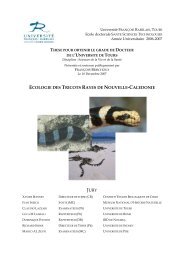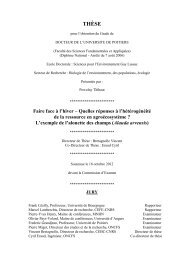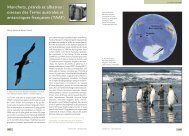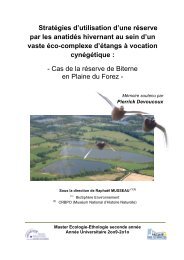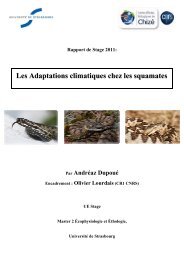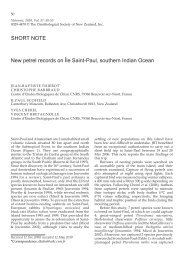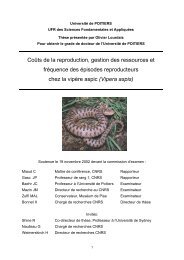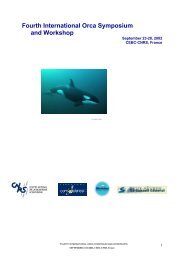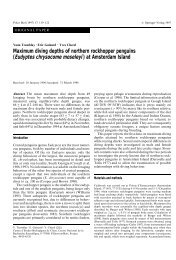Forçage environnemental et prédateurs marins ... - Cebc - CNRS
Forçage environnemental et prédateurs marins ... - Cebc - CNRS
Forçage environnemental et prédateurs marins ... - Cebc - CNRS
You also want an ePaper? Increase the reach of your titles
YUMPU automatically turns print PDFs into web optimized ePapers that Google loves.
Chastel, O, Weimerskirch, H & Jouventin, P. 1993. High annual variability in reproductive success and<br />
survival of an antarctic seabird, the snow p<strong>et</strong>rel Pagodroma nivea: a 27-year study. Oecologia 94: 278-<br />
285.<br />
Chastel, O, Weimerskirch, H & Jouventin, P. 1995. Body condition and seabird reproductive performance: a<br />
study of three p<strong>et</strong>rel species. Ecology 76: 2240-2246.<br />
Cherel, Y. 2008. Isotopic niches of emperor and Adélie penguins in Adélie Land, Antarctica. Marine Biology<br />
154: 813-821.<br />
Cherel, Y, Weimerskirch, H & Duhamel, G. 1996. Interactions b<strong>et</strong>ween longline vessels and seabirds in<br />
Kerguelen waters and a m<strong>et</strong>hod to reduce seabird mortality. Biological Conservation 75: 63-70.<br />
Cherel, ,Y, Weimerskirch, H & Trouvé, C. 2000. Food and feeding ecology of the neritic-slope forager black-<br />
browed albatross and its relationships with commercial fisheries in Kerguelen waters. Marine Ecology<br />
Progress Series 207: 183-199.<br />
Cherel, Y, Bocher, P, De Broyer, C & Hobson, KA. 2002a. Food and feeding ecology of the sympatric thin-<br />
billed Pachyptila belcheri and Antarctic P. desolata prions at Iles Kerguelen, Southern Indian Ocean.<br />
Marine Ecology Progress Series 228: 263-281.<br />
Cherel, Y, Bocher, P, Trouvé, C & Weimerskirch, H. 2002b. Di<strong>et</strong> and feeding ecology of blue p<strong>et</strong>rels<br />
Halobaena caerulea at Iles Kerguelen, Southern Indian Ocean. Marine Ecology Progress Series 228:<br />
283-299.<br />
Cherel, Y, Weimerskirch, H & Trouvé, C. 2002c. Di<strong>et</strong>ary evidence for spatial foraging segregation in<br />
sympatric albatrosses (Diomedea spp.) rearing chicks at Iles Nuageuses, Kerguelen. Marine Biology 141:<br />
1117-1129.<br />
Cherel, Y, Phillips, RA, Hobson, KA & McGill, R. 2006. Stable isotope evidence of diverse species-specific<br />
and individual wintering strategies in seabirds. Biology L<strong>et</strong>ters 2: 301-303.<br />
Cherel, Y & Hobson, KA. 2007. Geographical variaiton in carbon stable isotope signatures of marine<br />
predators: a tool to investigate their foraging areas in the Southern Ocean. Marine Ecology Progress<br />
Series 329: 281-287.<br />
Cherel, Y, Ducatez, S, Fontaine, C, Richard, P & Guin<strong>et</strong>, C. 2008. Stable isotopes reveal the trophic position<br />
and mesopelagic fish di<strong>et</strong> of female southern elephant seals breeding on the Kerguelen Islands. Marine<br />
Ecology Progress Series 370: 239-247.<br />
Chuine, I & Beaubien, EG. 2001. Phenology is a major d<strong>et</strong>erminant of tree species range. Ecology L<strong>et</strong>ters 4:<br />
500-510.<br />
Clarke, A. 1985. Food webs and interactions: an overview of the Antarctic system. In: Antarctica, Bonner,<br />
WN & Walton, DWH (Eds.). Oermagon Press Ltd, Oxford, UK, p. 381.<br />
Clarke, A. 1988. Seasonality in the Antarctic marine environment. Comparative Biochemistry and Physiology<br />
90B: 461-473.<br />
Clarke, A & Leakey, RJG. 1996. The seasonal cycle of phytoplankton, macronutrients, and the microbial<br />
community in a neashore Antarctic marine ecosystem. Limnology and Oceanography 41: 1281-1294.<br />
Clobert, J, Lebr<strong>et</strong>on, J-D, Allaine, D & Gaillard, J-M. 1994. The estimation of age-specific breeding<br />
probabilities from recapture or resightings in vertebrate populations. II. Longitudinal models. Biom<strong>et</strong>rics<br />
50: 375-387.<br />
Clobert, J, Le Gaillard, J-F, Cote, J, Meylan, S & Massot, M. 2009. Informed dispersal, h<strong>et</strong>erogeneity in<br />
animal dispersal syndromes and the dynamics of spatially structured populations. Ecology L<strong>et</strong>ters 12:<br />
197-209.<br />
94



